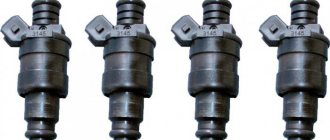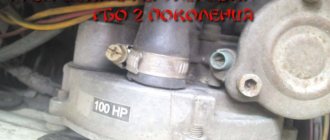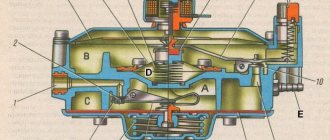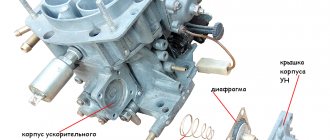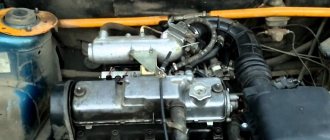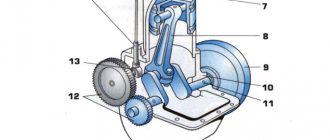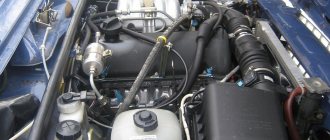Adjusting HBO on a carburetor engine
Adjusting the gas equipment on a carburetor engine is very important to ensure its normal operation. This article discusses how to connect gas equipment to a carburetor - a step-by-step procedure for performing such work, taking into account the features of various equipment.
Electronic gear adjustment procedure
An electronic gearbox, such as Tomasetto, provides for two main gas adjustments on carburetor cars:
- pressure in the second stage (it can be called sensitivity);
- the volume of gases passing through the channel at idle.
The engine must be started on gasoline fuel and warmed up to the nominal temperature level. The idle speed is set to one thousand per minute. The supply is turned off and gasoline is produced. The adjustments are in the following starting position:
- maximum eversion of the dispenser (the gas channel is open to the largest cross-sectional area; with a two-section chamber, each chamber is adjusted separately: for the first - the largest opening, for the second - the minimum);
- the screw that determines the idle speed is screwed to the extreme position and unscrewed five turns;
- the screw adjusting the sensitivity is installed in an intermediate position.
First you need to set the idle speed. To do this, the car starts on gas fuel, using a choke, the speed is set to two thousand per minute. Then the choke is gradually removed, and by rotating the screw that determines the idle speed, the speed is set to the maximum. These operations are repeated until the choke is completely removed and the engine operates stable in idle mode.
The maximum speed is set using the idle speed screw. The screw that determines the sensitivity is gradually tightened. When the speed is lost, they are added by the screw that regulates the idle speed. If this does not work, then the sensitivity adjustment is tightened a couple of turns and the procedure is repeated.
At the end of the adjustment, this screw will be screwed in almost all the way, and the engine speed when idling reaches its maximum value - about 1.2 thousand per minute. After this, this indicator is reduced - slightly below the nominal value, by tightening the idle speed screw, then, unscrewing it slightly, it is set to about a thousand revolutions per minute.
Next, you need to adjust the sensitivity of this unit: the adjustment of the same name is gradually turned away until it affects the engine speed when idling, and it is twisted approximately one turn in the opposite direction. If everything is done correctly, when you press the gas pedal sharply, the power plant should respond responsively.
The third step is to set up the dispenser. With the engine running, the revolutions are set to three and a half thousand per minute, and the screw of the mechanical gas dispenser is tightened until they begin to change. Then this adjustment must be turned back half to three-quarters of a turn.
For a two-section dispenser that provides for separate settings in sections, the above applies to the first of them, the second is placed at a third of the previously configured ones.
If the pressure in your reducer is adjusted in the first stage, then turn off the motor and close the gas flow pipe. Then, using the control hole, which is closed with a bolt, connect a pressure gauge to the cavity of the first stage, allowing you to measure pressure up to one and a half kgf/cm2.
The power plant starts up, and at idle the pressure level is set to about 0.4 kgf/cm2. Then the idle speed and sensitivity of the gearbox are adjusted again. You should take into account the increased gas hazard of these works, therefore, if you are not confident in the reliability of the connection, you need to contact a service center.
Attention! Work on adjusting the two-section dispenser poses an increased gas hazard. Be careful.
Setting up the vacuum reducer
There are two types of vacuum reducers:
- providing separate adjustment at idle speed, as well as sensitivity;
- having a combined regulator of these two settings.
In the first case, the adjustment is carried out similarly to the adjustment of the electronic gear described above. If the regulator is combined, as in the 2nd generation Lovato LPG for cars with a carburetor, the adjustment is as follows:
- the car starts using gas, the speed is adjusted by suction, up to two thousand per minute;
- the choke is gradually removed, the speed is set to maximum by tightening the screw that adjusts the idle speed;
- The same adjustment adjusts the number of revolutions, about a thousand per minute or a little more;
- With a similar setting, the speed is further reduced below the nominal value, and then again rises to a thousand per minute.
This is how the 2nd generation Lovato LPG is configured for the carburetor.
Adjusting the dispenser
The final step is setting up the dispenser. To do this, you need to start the car on gas fuel and set the speed to about three thousand per minute. There is no need to use suction, it is better to involve a partner. Then the screw that regulates the dispenser is tightened until the speed begins to change.
You need to fully verify the presence of this boundary by playing with the screw in one direction or the other. From this threshold, the adjusting screw is unscrewed by half to three-quarters of a turn. After a slight adjustment of the idle speed, the gas injection system for the carburetor can be considered configured.
It is also recommended to check the correct settings of gas equipment for a carburetor engine based on the concentration of oxygen and carbon monoxide in the exhaust. The CO level should not exceed 0.45%. Adjustment is carried out using screws that supply air to the carburetor and regulate the idle speed of the gearbox. If the indicator is underestimated, you need to add it to the second of the specified settings; in the opposite situation, vice versa.
Methane to the carburetor
If the fuel used is not a propane-butane mixture, but methane, the installation scheme for gas equipment changes. On the electrical part, everything remains unchanged, but the technical part from the cylinder to the gearbox is changing. The main difference between propane and methane is the operating pressure. For methane it is 200 bar. This imposes special conditions and standards on the installation of all components.
Let's start with the balloon. For methane, special cylinders operating at this pressure are intended. The main line is seamless steel. Other gas reducers are also used, in the design of which a reduction chamber is added, in which the methane pressure is reduced to 1.5-2 bar. They do not have an evaporator, since the normal state of methane is vapor, but a reducer is connected to the cooling system. This is necessary to warm up the incoming compressed gas. The indication of the amount of gas remaining in the cylinder is determined by a 0-400 bar pressure gauge. Perhaps these are all the main differences between methane plants and propane plants.
And finally, I advise you to watch a video about the operation of an LPG on a carburetor.
HBO 1st generation, elements, principle of operation
Due to the lack of standards and clearly defined divisions for certain generations of gas equipment in the post-Soviet space, we will adhere to the divisions into gas equipment generations generally accepted by installers, which are slightly different from the pan-European ones. In the current article, we will look at the constituent elements, operating principle, advantages and disadvantages of 1st generation LPG on a carburetor.
How to install 1st generation HBO
The installation process includes several stages:
- Selecting a location and installing a cylinder. In passenger cars it is placed in the trunk, in trucks and jeeps - under the body.
- Installation of the high pressure line and gearbox in the engine compartment.
- Insertion and connection of the cooling system. Done for the stove.
- Installation of gasoline and gas valves. The first one cuts into the hose from the fuel pump to the carburetor on the left side of the engine compartment, the second is placed on the opposite side.
- Installing the regulator using pipes and a mixer.
- Connection, system sealing and adjustment. Performed manually.
The gas installation on a 1st generation car can be installed independently. But this requires knowledge, skills, equipment and compliance with safety measures. But since the equipment will need to be registered with the traffic police, documentation is required confirming the correct installation. Therefore, after self-installation, you will still have to contact a certified service station that deals with gas equipment, so that they can provide such documents, having first checked the correctness of the work performed.
Installation on a car with a carburetor engine
For the carburetor, installation can be used both for a propane-butane mixture and for methane. The latter is most often installed on commercial vehicles. The difficulty lies in the weight and dimensions of the cylinders. In addition, there are not many methane gas stations. Therefore, for passenger cars it is recommended to install equipment under propane-butane.
Installing and configuring 1st generation HBO on a carburetor is simple. All you need is good components and skills in working with tools.
Installation on an injection engine
Installing a 1st generation LPG on an injector is no different from installing it on a carburetor, except that instead of a gas valve, an injector emulator is used to cut off gasoline. When gas is supplied, it imitates the operation of gasoline injectors, eliminating the transition of the working computer to emergency mode. Therefore, a lambda probe emulator is used.
Another difficulty is setting up the equipment on an injection engine. The system does not provide feedback, without which it is difficult to properly configure the operation of the computer and fuel pump. It is recommended to do this at a service station.
Maintenance comes down to checking connections, rubber seals and replacing filters.
Accessories
The first generation of HBO (the first by European standards) is a generation with a minimum of electronics. The 1st generation of HBO includes:
- vacuum type gearbox,
- fuel type selection button,
- mechanical dispenser,
- mixer,
- lines (refueling and consumable),
- multivalve,
- filling valve,
- gas solenoid valve,
- gasoline solenoid valve,
- gas cylinder.
How does it work
The principle of operation of 1st generation HBO is as follows:
- The propane-butane mixture, located in a cylinder under a pressure of 1.6 MPa, flows through a multivalve and a flow line to the electric gas valve.
- When the driver switches the toggle switch to the “GAS” position, the electric valve opens and passes the liquefied propane-butane mixture into the evaporator reducer.
- In the gearbox, the mixture is heated using a line connected to it with the coolant of the internal combustion engine, evaporates and is supplied to the gearbox membrane.
- Depending on the operating mode of the engine (the vacuum created by it), the gas supply through the calibration hole in the gearbox to the mechanical dispenser is regulated.
- After this, the gas enters the mixer and, accordingly, into the internal combustion engine of the car itself.
The gas supply during engine operation is controlled by the presence of vacuum created by the engine during operation.
In the 1st generation gas equipment, to start a car engine on gas, a starting coil is used, which for some time opens the locking element in the discharge chamber from the gearbox to the dispenser, providing a starting portion of gas (controlled by a separate toggle switch on the fuel selection switch). Further, already during operation of the internal combustion engine, due to the vacuum created by it, the shut-off element is controlled by a membrane. The engine is running, therefore there is a vacuum and gas supply is present. Otherwise, there is no vacuum, which means the engine is not running and the supply is shut off.
HBO first generation
If you want, this is the starting point, this is where it all began. A propane-butane gas mixture is used, and methane gas is also often used. Such systems have their own tank, or gas cylinder, which is installed additionally, often in the trunk or interior of the car. It is this that is filled with gas, which enters through a shut-off valve into special equipment called an “evaporator”.
Next, in the “evaporator” (which is connected to the cooling system), the gas turns into a vapor state (if we take a methane system, then there is heating of the methane). Next, the gas enters the reducer, which, depending on the pressure in the intake manifold of the engine, doses the injection.
It should be noted that the first generation often used different evaporator and gearbox units, although later versions appeared that combined these two devices in one housing.
The first types of gearbox used a vacuum valve in their structure, which opened only when low pressure (vacuum) appeared in the intake manifold - hence the first types are called “vacuum”.
After this, the gas mixture must enter the manifold through a carburetor or a special mixer (which was also installed separately). This construction of the system is, to put it mildly, “not ideal”; the gas needs to travel a fairly large distance - which leads to all sorts of problems. For example, difficult starting (especially when starting a cold engine when the vacuum is weak). Such systems were even equipped with a special “suction pump” - which allows you to open a direct supply of gas to the engine, and the gasoline mixture was completely turned off.
If we take the methane versions, then they had reduction chambers in which the gas pressure was greatly underestimated, by about 15 - 3 BAR
Installation of these systems is only for carburetor engines, which is why it is the first generation. It had many disadvantages - especially if the system depressurized over time, then you could hear popping noises when starting up, and fires were not uncommon.
HBO 1 on the carburetor
The basic algorithm for the operation of 1st generation LPG on a carburetor car is as follows:
- The switch button is in the “Gasoline” position and the corresponding indicator on the button lights up.
- Gasoline from the gasoline pump, through the open gasoline electric valve, enters the carburetor float chamber.
- The electric gas valve is closed.
- The car starts up in its usual, so to speak, normal mode using native fuel.
- As the engine warms up (usually when the coolant reaches a temperature of 40 degrees Celsius), the driver moves the fuel switch to the neutral position in which both electric valves (petrol and gas) are closed.
- At this time, the engine produces residual gasoline in the float chamber. Then, when the engine has exhausted all the fuel from the float chamber and tries to stall, the driver moves the fuel type switch to the “GAS” position and the engine starts running on propane-butane.
To do this, the driver moves the fuel type switch to the “GAS” position, simultaneously presses the starting coil control toggle switch and turns on the ignition and starter.
It is worth noting that trying to start a car on gas leads to accelerated wear of the evaporator gearbox parts, in particular the rubber membrane that comes into contact with the coolant.
The principle of operation of a carburetor
The equipment works as follows:
Gas under pressure of about 15-17 kgf/cm2 is supplied through a pipeline from the cylinder to the evaporator reducer. In it, the gas pressure decreases to the required level and the gas transitions into a gaseous state (in the cylinder it is in a liquid state).- Also in the reducer, the gas is heated (coolant supply hoses are connected to it) to a temperature of about 40-50°C. In a vacuum reducer, gas is supplied after the diaphragm opens as a result of the appearance of vacuum in the intake manifold. Typically gearboxes are equipped with two screws to adjust sensitivity and idle speed.
- After the reducer, the gas is supplied to the intake tract of the internal combustion engine . The difference between the 1st and 2nd generation gas equipment is that a mechanical gas portion dispenser is installed after the gearbox (in the 3rd generation equipment, an electronic gas quantity regulator is used instead). After this, the gas enters the engine through a mixer.
- To switch between two types of fuel, a special button is used , which is mounted in the car interior. For cars with carburetor engines, a button with modes “Gasoline”, “Gas” and “0” is used. Kits for injection internal combustion engines use buttons in which, instead of the “0” position, the “Semi-automatic” mode is available.
- If a 1st generation gas installation is mounted on a car with a carburetor engine, a valve is installed in the gasoline pipe in front of the carburetor. When selecting the “Gas” mode, the supply of this type of fuel is cut off. The fuel pump continues to work, but fuel bypasses the carburetor. The gas valve coil is constantly connected to 12V, it is in the open state and provides gas supply to the evaporator reducer.
- When the “Gasoline” mode is selected, the valve on the gasoline line is activated and ensures the supply of gasoline to the carburetor. At the same time, the gas valve turns off the gas supply. In mode “0”, gasoline residues are produced in the carburetor. When it is turned on, neither gas nor gasoline is supplied to the carburetor.
- In cars with injection and mono-injection internal combustion engines, the “Gas” mode is responsible for deactivating gasoline fuel injectors (the fuel pump continues to operate). The gas valve is in the open position and provides gas supply. The “Gasoline” mode turns on the gasoline injectors and turns off the gas valve.
The supply of gas fuel is regulated depending on the presence of vacuum, which is created during operation of the internal combustion engine. Starting the engine on gas fuel is possible thanks to the starting coil.
For a certain time, it opens the supply of a small portion of gas necessary to start the engine (this function is controlled by a special toggle switch in the cabin).
After starting the motor, a vacuum is created, thanks to which the gearbox membrane controls the locking element in its unloading chamber. As long as there is a vacuum, gas is supplied. As soon as the vacuum disappears due to the engine stopping, the fuel supply stops.
Advantages and disadvantages of the first generation
The advantages of the first generation of HBO are:
- simplicity of design,
- relative cheapness of equipment,
- minimum electronics.
Disadvantages of 1st generation HBO:
- it is not possible to automatically switch from gasoline to gas, and vice versa,
- the occurrence of failures in engine operation under certain operating modes,
- loss of power and vehicle dynamics in some engine operating modes,
- “delayed” reaction to the accelerator pedal.
Read about how to install LPG on a carburetor car in this article.
Source
HBO 1st generation
The history of the use of gas as fuel in cars begins with the history of the creation of the car itself. In those distant times there was no gasoline or diesel fuel. The first engines ran on illuminating gas or produced gas for the engine in installed gas generators that produced gas from wood.
The first gas cylinder systems began to be installed in the USSR back in the 30s of the last century. Currently, gas cylinder equipment from the first to the sixth generation is being installed. Although there is no exact classification by generation and the differences between 1st and 2nd generation HBO are insignificant. Such equipment is installed on all carburetor engines. First generation gas equipment is mounted on both injector and engines with central injection.
1st generation gas equipment is actively used. There are many cars driving on the country's roads, more than 30% of them are carburetor-powered and almost all of them run on gas. The production of cars with carburetor engines was discontinued just over 10 years ago.
Differences between 1st generation HBO and the rest
1st generation gas equipment uses the principle of regulating pressure from a gas evaporator reducer during its subsequent mechanical dosage. This system is suitable for two types of engines:
- carburetor;
- injection (single injection).
The system uses both vacuum and electronic gas reducers, eliminating work with a lambda probe. This is the main difference from the second generation.
The gas supply has to be controlled manually using a dispenser. A switch on the dashboard will help you switch to gasoline. The fuel level in the tank is usually not displayed.
In the third generation, a stepper metering unit appeared, which regulates the flow into the intake manifold.
In the fourth, electromagnetic gas injectors appear, providing gas injection into each cylinder, similar to the injection of the main system. Dosing and determination of the injection phase are performed by a standard controller. Such gas equipment already provides automatic switching from one fuel to another.
The fifth generation LPG differs in that gas is supplied to the cylinders in liquid form. A pump installed in a gas cylinder pumps liquid gas to the nozzles and returns the excess back. The block diagram includes standard fuel maps and an electronic unit, as well as additional injectors and a ramp.
From generation to generation, gas equipment has become more efficient, more productive and more economical. The first generation gas equipment is simpler, costs less, but requires more fuel.
How does 1st generation HBO work?
The equipment of the first generation differs from subsequent generations primarily in its simplicity. Later generations acquired additional devices and electronics. But this did not affect the principle of operation of the engine gas supply system.
The 1st generation equipment operates as follows: automobile gas, a propane-butane mixture, enters the fuel cylinder through a filling device. Refueling occurs automatically until the cylinder is filled to 85% of its volume. The fuel filling process is controlled by a multifunctional valve. The built-in pressure gauge displays the filling level.
Through the high pressure fuel line, through the multifunction valve, the gas reaches the solenoid valve. This valve opens when the ignition is turned on. When the engine starts, gas flows through the line into the gearbox. The 1st generation GBO vacuum reducer is double-circuit, in it gas from a liquefied state is converted into a normal gaseous state.
Propane pressure drops from 12-16 atm. to 1 atm. When the pressure decreases, strong cooling occurs. The 1st generation GBO reducer freezes and becomes inoperable. To prevent this from happening, fluid from the engine cooling system is supplied to the gearbox. This allows the gearbox to be warmed, making mixture preparation more efficient.
The gas can no longer enter the combustion chamber, since its pressure is equal to atmospheric pressure. Therefore, there is no turnover. It uses vacuum, or vacuum, which is created in the cylinders during engine startup and operation. Since there is negative pressure in the open cylinders and pipeline, the gas rushes there.
To ensure that the gas supply is in the required quantity, a dispenser is installed on the low-pressure line immediately behind the reducer. Next, the fuel enters the gas mixer at the carburetor, mixes with the air passed through the filter, and enters the cylinders through the intake manifold.
There are installation methods that do not include a mixer (mixer). In this case, a fitting is cut into the bottom (spacer) under the carburetor or a “turtle” mixer is installed. Gas is supplied directly to the manifold, bypassing the carburetor.
How first generation gas equipment works
The principle of operation of HBO 1 is quite simple and is based on the supply of fuel to the combustion chamber using a pressure difference, from the tank to the gearbox and further to the cylinder-piston group.
It works as follows. During refueling, liquefied gas is under pressure from 12 to 16 atm. through the filling valve, through the fuel line through the multifunction valve, it is supplied to the fuel cylinder. Refueling is carried out under the control of a multi-valve until the tank is filled to 85% (for safety during gas expansion). The filling level is indicated on the valve pressure gauge.
After warming up the internal combustion engine on gasoline to 40-60 degrees, the driver moves the toggle switch to the neutral position, where the electric valve shuts off the fuel supply to produce the remaining gasoline from the carburetor.
Then the button is moved to the position of the engine running on gas. The propane solenoid valve opens and the gas flows through the tube through a coarse filter into the reducer, where it evaporates and the pressure drops to 1.0 (0.8) atm.
With a sharp drop in pressure, the gearbox cools down to the point of loss of performance. In order for the gearbox to fulfill its role, it is heated using engine coolant.
Next, the gas mixture, due to the difference in pressure (vacuum) in the engine cylinder and the fuel pipe, is “sucked” through the dispenser, into the carburetor and mixer, while the piston moves to the bottom “dead” point. Mixed with air in the mixer, the resulting propane-air fuel mixture enters the manifold through the open intake valve into the combustion chamber.
To start the engine directly on gas in warm weather, the reducer-evaporator device (for example, the Lovato reducer) includes a special valve for forced supply of a portion of gas, which is controlled by briefly pressing the LPG button from the passenger compartment.
Starting a car engine with HBO in winter
In winter, in severe frosts, it can be difficult to start a car even on gasoline, but on gas it becomes a problem. After all, the coolant in the engine is cold and it is simply not possible to warm the gearbox. In this case, the engine is started on gasoline. To do this, during installation, an electromagnetic valve is installed on the gas line; it operates only when the ignition is turned on.
To switch the engine from gasoline to gas, a three-position button is installed in the car interior, which has three operating positions “petrol - neutral - gas”.
- In the first position, gasoline is supplied, the gas is turned off.
- In the second position, both gas and gasoline are turned off.
- In the third position, the gas supply is turned on and gasoline is turned off.
This combination is needed to manage the transition from gasoline to gas. When the engine is started on gasoline and it has warmed up, the switch is switched to the “neutral” position, at this time the gasoline remaining in the carburetor burns out and only after that is switched to the “gas” position.
Why is it worth installing gas equipment?
- The price of gas is significantly lower and does not change so dramatically depending on the situation on the global economic market.
- Propane, butane and methane are cleaner than gasoline.
- The gas burns almost completely and leaves no harmful emissions behind.
- The octane number of the gas is higher, detonation does not occur when using it, and the load on the engine is less.
- When the fuel tanks are fully filled, the car will be able to travel 200-500 kilometers more.
After installing LPG, the car will be able to travel 200-500 kilometers more
Installation and configuration of HBO
GBO installation is carried out by specialized workshops. They are certified, have trained specialists and the necessary equipment and tools for installation. These same workshops sell equipment of various configurations, repair and service it.
You can install the 1st generation kit on a carburetor or injection machine and connect it yourself, but it is better to contact specialists; installation and adjustment will not be expensive. But there will be all the documents necessary for registration, since this is making changes to the design of the car. Failure to note this in the documents will result in a fine of 500 rubles for the first violation. In addition, installers' warranties will come in handy.
Connection diagram for 1st generation gas equipment to a carburetor
Equipment installation kit
This diagram shows what parts the 1st generation LPG consists of:
- Gas cylinder. Its capacity most often depends on the installation location. Installed outside the car or in the trunk, this eliminates gas leakage into the cabin.
- Multifunctional valve. Serves to control the filling and supply of liquefied gas.
- The ventilation device provides ventilation in case of leaks.
- High pressure liquid gas supply pipeline.
- Electric valve. Triggered to open the gas supply from the ignition switch
- Gasoline solenoid valve, the only function is to shut off the fuel supply when switching to gas.
- Vacuum reducer HBO 1st generation. Converts from liquid to vapor and reduces fuel pressure.
- The mixer (mixer) mixes the gas with atmospheric air to form a fuel-air mixture.
- Dispenser. Serves to regulate the amount of gas supplied.
- Refill connector. Refueling at the gas station takes place through it.
Gas equipment for carburetor
HBO of the first generations was intended for carburetor cars.
1st generation LPG was intended for carburetor cars
Last century? No, considering that 50 percent of the vehicle fleet in Russia consists of vehicles older than 10 years. More than 30 percent are cars produced by the Lada concern, plus a certain percentage of GAZ, UAZ, KAMAZ, and so on. And VAZ stopped producing carburetor models just 10 years ago.
For carburetor engines, gas cylinder equipment is the simplest. No electronics or sensors, just like the carburetor engines themselves. If you remove all the sensors and bells and whistles from fourth-generation gas equipment, you will get the first. The only negative is that if you install it on a carburetor, it needs adjustment periodically.
The carburetor engine or Otto power unit was popular in the world for a very long time until it was supplanted by a more economical and environmentally friendly injector. The injector was controlled by a computer; the adjustment of all systems and engine modes was entrusted to it. The carburetor was much simpler and more reliable than the injector. The carburetor of Hemi and other brands works quietly and after 50 years of operation, there is nothing special to break. An old American classic car with a huge multi-liter engine and a consumption of over 20 in quiet mode will come in handy with gas equipment.
Removing scratches on a car body without painting.
Read more >>
An old American classic car will come in handy with gas equipment
The carburetor did not have any electronic control systems, much less the injector. The carburetor regulates all the work with two holes and adjusting bolts, with the help of which the adjustment was made.
In the first generation, the dispenser is manual; it requires adjustment, just like the carburetor.
Diagram of gas cylinder equipment for a carburetor car
- Balloon. Usually mounted under the bottom of the car or in the trunk. And unfortunately, it takes up useful space.
- Multivalve. A special device located on the valve. Through it, liquefied gas enters the system.
- Refilling mechanism. Since the fuel is not liquid and is under pressure, it will not be possible to “pour” it into the neck. For these purposes, a special mechanism is used to safely connect the cylinder and the filling station.
- High pressure gas line. It's just a pipe through which gas flows.
- Gas filter. The gas is fairly clean, but it could contain debris.
- Gas valve. Locks or unlocks the gas supply.
- Reducer-evaporator. It is here that the gas returns to its normal state.
- Dispenser. They make the adjustments.
- Mixer. If it was not installed directly into the engine.
Gasoline valve
- Gasoline valve. Locks or unlocks the gasoline supply.
- Fuel switch. It is installed in the cabin and serves to switch the type of fuel.

